- Rule, Britannia, no more?
- Unpopular Opinions: US Quadball Cup 2023
- Proven Contenders: University of Virginia
- Proven Contenders: Rutgers University
- Proven Contenders: University of Michigan
- Proven Contenders: Creighton University
- Different Perspectives: A Look Inside USA Ultimate
- Antwerp QC, Much of Belgian Core, Leaves Competitive Quidditch
Community Team Conundrums: Schwartz, Oelze Discuss Future of Such Teams
With tryouts across the nation a mere two weeks away, I compiled a list of all active, USQ-official community teams. I then emailed one–time co-host of The Seeker Floor and, more importantly, Silicon Valley Skrewts Captain Kevin Oelze my thoughts, quandaries and concerns regarding community teams both this year and in the future. Below is the conversation that followed.
Noah Schwartz: Kevin, Seeing as you are an active member of one of the premiere community teams in the world (having reached the Sweet 16 at World Cup VII only to be knocked out on what might have been the last off-pitch snitch catch ever), you are in a unique position to address my concerns regarding community teams now and in the future. The first being the most pressing: Many people believe this is the year community teams will rise to the level of play expected of them last year due to the recurring influx of talent and continued maturation of the teams, but why is this year different from last year? Why are these new rosters—which will surely boast impressive depths of talent—be any different from the impressive rosters of WCVII? Aren’t we setting ourselves up for disappointment yet again?
Kevin Oelze: Why do you think that last season was a disappointment for community teams? Because Lone Star Quidditch Club got knocked out by Texas A&M University? Because the Lost Boys happened to flame out in the Round of 32? Sure, World Cup wasn’t great for community teams, but the difference between this year and last year is the number of lottery tickets. Last year, there were really two community teams you could hang your hat on as real threats to win World Cup: the Lost Boys and Lone Star. Lone Star didn’t disappoint, and the Lost Boys lost to an underrated Louisiana State University (LSU) team that matched up really well with their team.
But this year, there’s a chance of several more teams that are pushing in. There’s a great amount of talent in Boston that graduated, and if Q.C. Boston: the Massacre (QCB) can pick them up, that’s going to be a really scary team. Blue Mountain Quidditch Club’s (BMQC) got some nice depth, although I don’t consider them a real World Cup contender like I do Lone Star. The Lost Boys are probably losing too much to still be considered a title contender, and I’m not sure LA Gambit will have the depth,
I think the phantom everyone is scared of is essentially this: college teams are guaranteed to lose players over time, whereas community teams will just slowly absorb more and more talent. It’s more complicated than that though: you lose talent on a community team as people burn out and quit or get injured. I’m not sure I see this being some huge breakthrough year for community teams, but if Lone Star wins World Cup, you’ll hear people screaming foul and complaining that community teams have it easier.
Schwartz: I think it is fair to say WCVII was a disappointment for community teams, seeing as both Lone Star and the Lost Boys were odds on favorites to win the tournament, and both fell short of even reaching the Final Four. Both teams had a championship or bust mentality and to everyone’s surprise, they busted. It seemed, to me at least, that both teams were sitting in a Montreal casino with $100 on the line in a game of blackjack and were showing 20s only for the dealer to flip an 11 and land the face card… or maybe that analogy only applies to me. However, the troubles for community teams ran further than that last year. While your Silicon Valley Skrewts had themselves a fine tournament, the NYDC Capitalists failed to make day two, and QCB and the Santa Barbara Blacktips didn’t even reach the Round of 32. I shudder to mention the fates of other, less prominent community teams that simply could not compete at the level of their more famous peers. For community teams, expectation certainly failed to match reality.
You do lead me into my next question. Let us, for a moment, live in a hypothetical world where Lone Star wins World Cup VIII (or whatever name we will be using from now on) by 120 quaffle points. From the moment the final whistle blows and before Stephen Bell and takes a swig from his artfully hidden flask, every college team in America “cries foul.” Community teams currently have the ability to not only draw from the best graduates, but can, in fact, compete for the same players collegiate teams do and scour their cities and surrounding area for any athletes looking to try a new sport. It seems that the talent disparity will only continue to grow between the college ranks and their community counterparts, and a Lone Star win would demonstrate the disparity. So what do we do about it? Do we restrict eligible players from community teams? Grow player pools for collegiate teams? Split the two types of teams and hold separate championships? Or am I overblowing the talent disparity issue entirely and nothing needs to be done because, to this day, no community team has ever won a domestic title? Am I wrong in thinking that this question might be the heart of a much more complex idea about what the future of our sport looks like?
Oelze: I do think that you’re overstating how much Lone Star and Lost Boys were “favorites” to win the Cup. It’s hard to win a championship. Even if you’re a favorite to the degree that you have a 70% chance of winning every bracket game from the Sweet 16 onward, you only have a 24% chance of actually winning the whole tournament. Obviously there was no team that had a 70% chance of beating a Texas A&M or Baylor University, so that’s a really aggressive estimate of how likely a team might have been to win the World Cup.
At some point, as much as I hate this and I dread this day, you have to split the championships. The teams just aren’t on the same playing field. However, I think that point may be further away than you think: teams are still competing with community teams. I really think that the geographically distributed “all star teams” like Lone Star are going to be the problematic teams. Community teams are traditionally restricted to players in their area, but as that area grows and grows, it becomes impossible for college teams to compete. Of course, as that area grows, the ability to have everyone practice together diminishes, and that’s a huge advantage for more locally concentrated teams.
I really think Lone Star is the scariest model. You have large chunks of concentration, so you can still have weekly practice. You also have people committing to travelling long distances every month for a full squad practice, which may as well read as a who’s who of the Southwestern region. They’re sitting here as my World Cup favorites.
Schwartz: You talk about a split at some point in the future, and I think that splitting community teams from collegiate teams and running two separate championships is, right now, the most popular held opinion on the best way to handle a competitive gap that may arise between the two types of teams. There are some serious issues that come with that situation though, and if I was on a community team that format would terrify me.
View Community Teams* in a full screen map
Firstly, qualification and travel expenses (take a look at my map above for an idea). One would assume that in order to qualify for this community championship, a team would have to play a set amount of games against other community teams. For the Skrewts or QCB, this might not be a big deal, community teams are far more dense out on the coasts, but for a team like Lone Star or Blue Mountain, traveling just to play qualification games would cost an insane amount of money per player. Considering that community teams are not school affiliated,what would you propose as a solution to this potential problem? I think advertising would gain a certain amount of momentum in this situation, but I doubt any deal a team could make with a company at this point in time or the near future would be lucrative enough to fund the kind of expenses they would pile up.
Secondly, a split might really hurt USQ’s bottom line. Having to plan and execute two different championships either during the same weekend or a different one would leave them stretched for resources and potentially understaffed. Not to mention the further need for snitches and refs. It seems to me that a split might not be all that great for anybody. Am I crazy to think that if a split were to become the best option, we just set up two different governing boards all under USQ direction? One board to handle collegiate quidditch and one to handle community quidditch (or “semi-pro,” but Domingo Ayala would not be happy with that designation).
Oelze: Oh, I absolutely agree. I think from a logistical standpoint, it’s kind of terrifying. I think the easiest way of solving it would be to keep regular season essentially identical: have the college and community teams mix and play each other, and the only real change is you have to split the World Cup into two tournaments (or two divisions at the same tournament). It’d be obnoxious for us to have to travel. The nearest community team to us other than the Skyfighters is in Los Angeles, which is a six hour drive for us. If we have to make that drive four to five times a year, that’s still upping our travel costs a lot, even though we’re not flying. Don’t even get me started on what that’d do to Lone Star or BMQC.
Of course, that ignores things like, “How do community teams qualify for their division of World Cup?” which becomes completely unsolved by that answer. The truth is, I don’t know if there is a really good way to handle it that doesn’t screw over community teams logistically. As a team that hasn’t really raided (actually, this is an interesting point—I’ll come back to this later, because you could argue from some perspective that we have) other teams, it’d be frustrating to see us walled off from college teams because of advantages that we really haven’t had.
Anyway, back to the raiding thing: we picked up three players who originally played for college teams last year. In all three cases, the player approached us without us actually trying to recruit them or steal them from the team. I don’t know if there was a lot of pressure in similar situations from the team who was getting the players or if the players just decided they wanted a change of pace (for instance, I don’t know how the individual choices for QCB vs. Emerson College went), but even if you aren’t actively recruiting at people, people will still come to you and try to join you from collegiate teams. You aim to build your team “the right way” and still end up being those guys who are just grabbing up any players they can get.
Schwartz: This raiding teams thing is an interesting thread of thought to get into. I guess my only question on this topic is should players enrolled in college be allowed to play for community teams? If this loophole was fixed, it might allow college teams a chance to be competitive longer. If colleges were allowed to have more than one official team, say an A- and B-team, it could give them a sort of farm system to grow players during their first couple of years. This could be an advantage given to college teams to possibly avoid having to split the two types of teams into different play brackets.
Furthermore, do you think it is appropriate for community teams to go after the same players as college teams? When a freshman class comes in or there is a rumor of a disgruntled player on a team, what do you think is the appropriate protocol for say, a team captain or star player of a community team to proceed with? I don’t think quidditch is quite the zero sum game that other collegiate athletics are because, as of right now, nobody’s livelihood is at stake. We see it with snitches, refs and gameplay directors who should have agendas of their own and attempt to fix matches to benefit their teams but don’t because they hold the integrity of the game above their personal and team goals. Should these same standards apply to recruitment of players in regards to community teams poaching colleges or is this case special in some way?
Oelze: I think it’s really lousy to say, “Oh, you go to this college, so you can ONLY play for this team.” Heck, if that’s the case, the Skrewts would have lost players as time went on because some of them played with us before college and then they would have to go to their college team. But I think it’s a really sensitive issue because if you have some star player playing for Shitstown State, in order to stay competitively viable, teams SHOULD be trying to recruit that player. But that means if you’re not a team that’s already succeeding, you’re extremely likely to stay behind, as any strong talent you get is going to be poached. I think that ultimately the move was for the best, but the actual first-ever IQA transfer was Tony Rodriguez’s transfer from the Hollywood Harpies to the Lost Boys, and I know some of the more competitive Harpies ended up really bitter about the fact that their one genuine star player was taken from them. At the same time, I don’t fault Rodriguez—there was a total competitive personality mismatch between Rodriguez and the team, and when a clearly better team is constantly trying to recruit you, how do you stay strong and stay no? Really, the answer is you don’t, and so the rich get richer while the poor get poorer. I’m not sure what USQ can do to stop this, if they even should be trying to stop this.
I don’t think the case is special at all, honestly. From a USQ rules perspective, it’s kill or be killed in terms of recruitment, and the only real gate of it is the USQ Gameplay Department, which has generally been extremely liberal about letting transfers through. But you would not believe how angry teams that get a single transfer denied get. It’s borderline ridiculous: teams act as if they should have the license to add anyone they want. However, I think in the majority of cases, most teams are respectful enough that they won’t go after star players, just like most referees uphold the integrity of the game. There are bad apples in both cases (and no, I’m not starting a witch hunt here). Honestly, I think it’s kind of bush league for a community team to initiate the recruiting, but I have trouble faulting any team listening to players who want to join their team.
It’s a great feeling if you’re on one of those teams that everyone wants to join because you have really easy ways to upgrade your team during the season without much effort, but, man, it has to be really discouraging for teams that are simply trying to get off the ground. I don’t see how any truly “new” community team can form and have success in any area that has a more established community team right now, because the more established community team will just swoop in and take the best players (I don’t consider a team like Gambit “new,” as they’re not forming from new players). I think this will go even worse if more teams adopt the distributed Lone Star model, because you can cover so much ground that your team can recruit from.
Schwartz: Well, Kevin, thanks for all your time. I just have one more question for you. I’m giving you the final word (and in the process granting myself the authority to give you the final word) on an age-old quidditch question: Who would win in a fight? 100 duck-sized Dan Hansons or one Dan Hanson-sized duck? Choose wisely.
Oelze: 100 duck-sized Dan Hansons. They have human intelligence and would be smart enough to give the Dan Hanson-sized duck poisoned bread.
*Don’t see your team on the map? Shoot Noah.Schwartz@eighthman.com the registered name, location and a social media link. Please do not submit your team unless it is an official, registered team within your league.
About Noah Schwartz
Noah is currently a member of the Tufts University quidditch team. He is co-host of The Seeker Floor, and an all-around above average guy. There is nothing particularly special about him, but he really loves sports and is good friends with Seeker Floor co-host Ethan Sturm. Basically, Noah's spot on staff was given to him in order to appease Ethan.

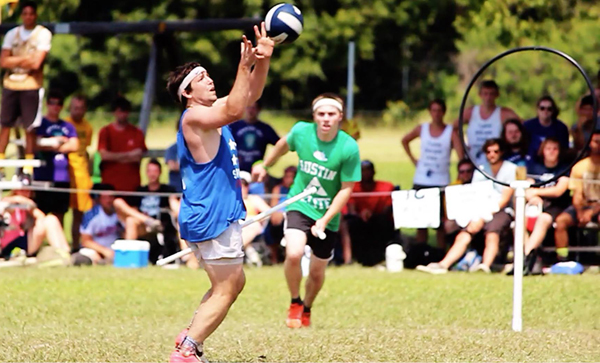
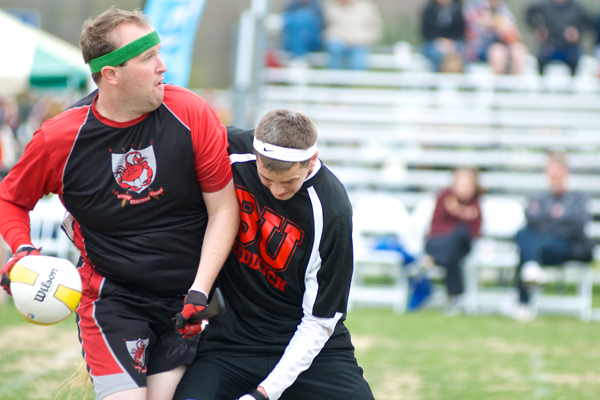
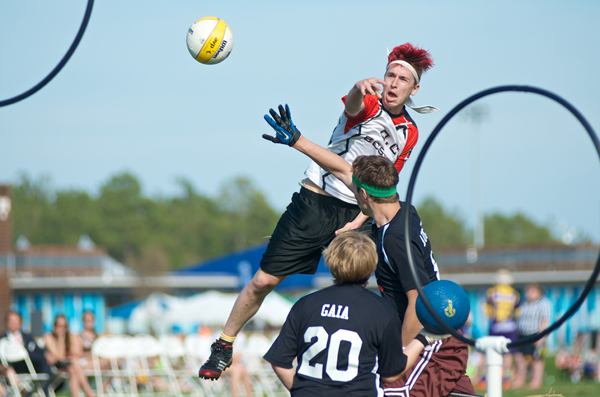
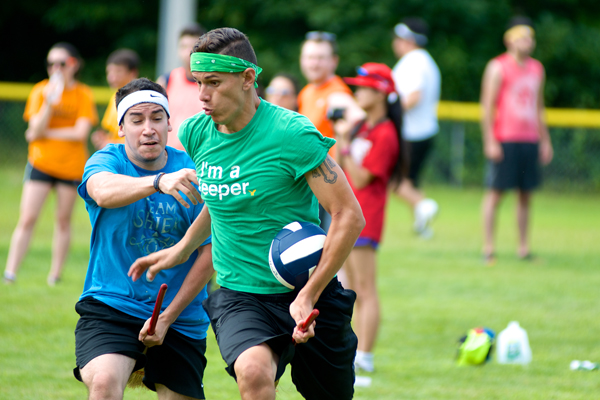


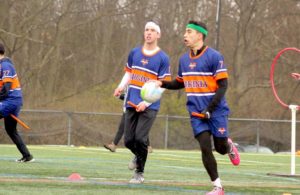
One Comment